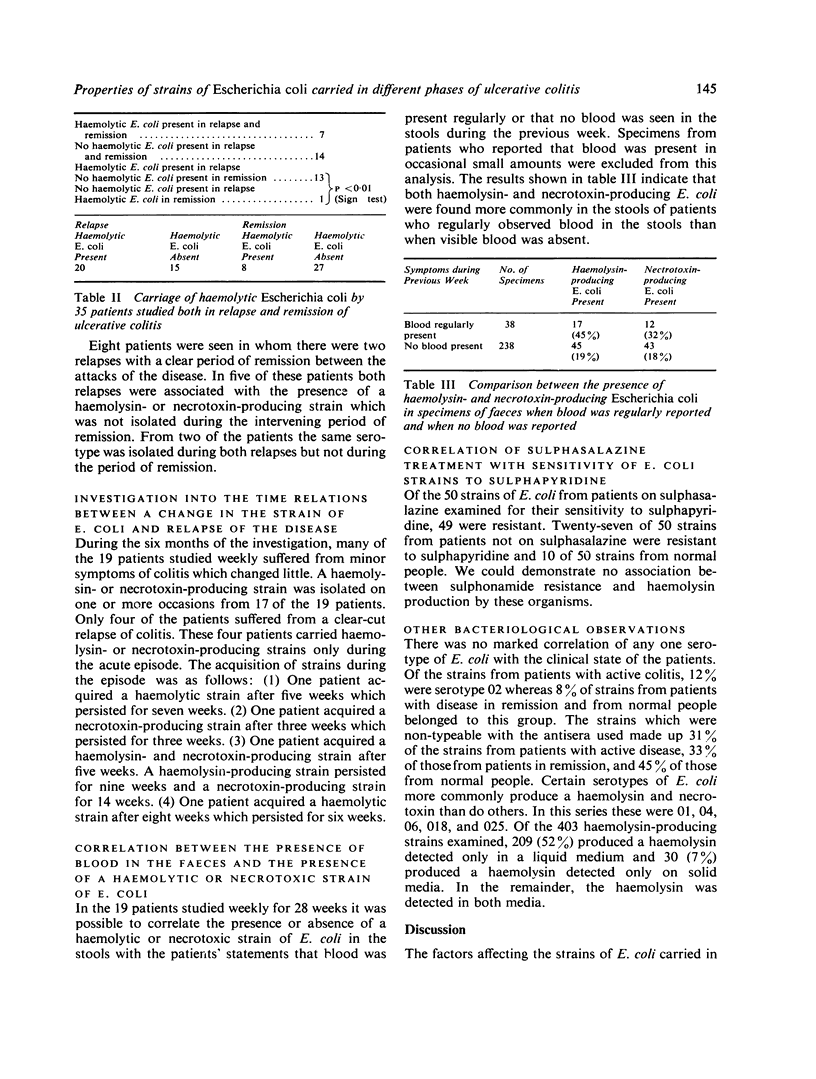Abstract
Strains of E. coli from the faeces of patients with active ulcerative colitis and with colitis in remission were examined for haemolysin and necrotoxin production. Cultures from 63 patients with active colitis grew haemolytic E. coli in 23 (37%) as compared with 24 (21%) from 115 patients whose disease was in remission (p < 0·05). The corresponding proportions for necrotoxin-producing strains were 22% and 12%. Of 35 patients investigated both in relapse and remission of the colitis, 14 changed their carriage of haemolytic E. coli. Thirteen of these carried haemolytic organisms in relapse but not in remission, and one carried haemolytic organisms in remission but not in relapse (p < 0·01).
Strains of E. coli were also examined from specimens of faeces obtained at weekly intervals for 28 weeks from 19 patients. The acquisition of haemolytic or necrotoxic E. coli strains tended to follow rather than precede the onset of the attack in the four patients who developed a relapse of the disease during this period. Among these 19 patients haemolytic and necrotoxic strains were found most commonly when blood was regularly present in the faeces. These facts suggest that conditions in the bowel during a relapse of colitis tend to favour the presence of haemolysin- and necrotoxin-producing organisms, rather than that these organisms cause the relapse.
Of 50 strains of E. coli from patients treated with sulphasalazine tested for sensitivity to sulphapyridine 49 were resistant. There was no clear relation between the activity of the colitis and the presence of any of the 27 serotypes of E. coli examined.
Full text
PDF



Selected References
These references are in PubMed. This may not be the complete list of references from this article.
- Cooke E. M., Ewins S., Shooter R. A. Changing faecal population of Escherichia coli in hospital medical patients. Br Med J. 1969 Dec 6;4(5683):593–595. doi: 10.1136/bmj.4.5683.593. [DOI] [PMC free article] [PubMed] [Google Scholar]
- Cooke E. M., Hettiaratchy I. G., Buck A. C. Fate of ingested Escherichia coli in normal persons. J Med Microbiol. 1972 Aug;5(3):361–369. doi: 10.1099/00222615-5-3-361. [DOI] [PubMed] [Google Scholar]
- Cooke E. M., Kumar P. J., Shooter R. A., Rousseau S. A., Foulkes A. L. Hospital food as a possible source of Escherichia coli in patients. Lancet. 1970 Feb 28;1(7644):436–437. doi: 10.1016/s0140-6736(70)90830-5. [DOI] [PubMed] [Google Scholar]
- Cooke E. M. Properties of strains of Escherichia coli isolated from the faeces of patients with ulcerative colitis, patients with acute diarrhoea and normal persons. J Pathol Bacteriol. 1968 Jan;95(1):101–113. doi: 10.1002/path.1700950112. [DOI] [PubMed] [Google Scholar]
- Gorbach S. L., Nahas L., Plaut A. G., Weinstein L., Patterson J. F., Levitan R. Studies of intestinal microflora. V. Fecal microbial ecology in ulcerative colitis and regional enteritis: relationship to severity of disease and chemotherapy. Gastroenterology. 1968 Apr;54(4):575–587. [PubMed] [Google Scholar]
- LENNARD-JONES J. E., MISIEWICZ J. J., CONNELL A. M., BARON J. H., JONES F. A. PREDNISONE AS MAINTENANCE TREATMENT FOR ULCERATIVE COLITIS IN REMISSION. Lancet. 1965 Jan 23;1(7378):188–189. doi: 10.1016/s0140-6736(65)90973-6. [DOI] [PubMed] [Google Scholar]
- SEARS H. J., BROWNLEE I., UCHIYAMA J. K. Persistence of individual strains of Escherichia coli in the intestinal tract of man. J Bacteriol. 1950 Feb;59(2):293–301. doi: 10.1128/jb.59.2.293-301.1950. [DOI] [PMC free article] [PubMed] [Google Scholar]


